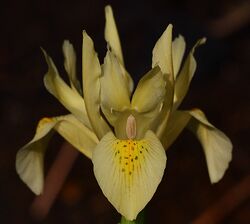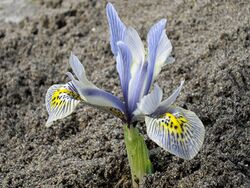Biology:Iris winogradowii
| Iris winogradowii | |
|---|---|

| |
| Scientific classification | |
| Kingdom: | Plantae |
| Clade: | Tracheophytes |
| Clade: | Angiosperms |
| Clade: | Monocots |
| Order: | Asparagales |
| Family: | Iridaceae |
| Genus: | Iris |
| Subgenus: | Iris subg. Hermodactyloides |
| Section: | Iris sect. Reticulatae |
| Species: | I. winogradowii
|
| Binomial name | |
| Iris winogradowii (Fomin)
| |
| Synonyms[1] | |
|
Iridodictyum winogradowii (Fomin) Rodion. | |
Iris winogradowii is a species of flowering plant in the genus Iris, classified in the subgenus Hermodactyloides and section Reticulatae. It is a bulbous perennial, from the Caucasus mountains of Azerbaijan and Georgia.
Description
It has pale primrose yellow flowers,[2] with green spots on the falls,[3] the scented flowers are up 5 cm tall and emerge between April and May.[4] With stem and flower the plant reaches a height of 10–15 cm.[3] The leaves emerge after flowering and grow up to 30–40 cm.[4] It has between 2–4 leaves each growing season.[5]
Taxonomy
It is sometimes known from the common name of Wingradoff's iris.[2]
It was named after P.Z. Winogradow-Nitikin who first described it.[4]
It was first found in 1914 and then published and described by Aleksandr Vasiljevich Fomin in 'Schedule Herb Flora Caucasus'. Vol.4 on page 88 in 1914.[6][7]
An illustration was seen in 1961 in the 'Collins Guide to Bulbs'.[8] It was grown in Australia from seed provided by the Komarov Botanical Institute in St. Petersburg in 1972.[9]
It was verified by United States Department of Agriculture and the Agricultural Research Service on 4 April 2003, then updated on 1 December 2004.[7]
Iris winogradowii is an accepted name by the RHS.[10] The iris later gained the RHS's Award of Garden Merit.[11]
Distribution and habitat
It is native to temperate Asia.[7]
Range
It is found in Azerbaijan and Georgia.[7]
In 1972, Dr Rodionenko noted that several hundred iris plants were on Mount Lomtismta near Bakuriani, (in Georgia).[12]
Habitat
In 1914, it was originally found in the gravelly soils of the alpine meadows of Mount Lomtismta. Part of the Caucasus regions of Adzharo-Imeretinskiy Range.[13]
Conservation
The plant is now on the 'endangered' list. Now only found in the republics of Georgia and Abkhazia.[9][14] Only a couple of hundred plants existed in 1978.[5] In the Caucasus mountains, it is at risk of extinction due to the over-collection of the flowers and bulbs.[15]
Cultivation
It was first grown in the UK in 1923.[4]
Due to its alpine origins, it prefers to grow in semi-shade in cool peat enriched soils.[16]
It is normally grown in a rock garden, alpine house or bulb frame.[5] In gardens it prefers humus-rich, porous soil in cool shade and does best if replanted each year after a fairly dry summer.
It has been remarked that this species is difficult to grow in a pot.[3]
Cultivars
In 1960, E.B. Anderson created the hybrid of Iris histrioides and Iris winogradowii. He then named the plant after the wife of a fellow enthusiast, Eliot Hodgkin (mother of Sir Gordon Howard Eliot Hodgkin).[3] Iris Katharine Hodgkin has light blue standards and pale yellow falls.[17]
Iris 'Sheila Ann Germaney' is another hybrid between Iris histrioides and Iris winogradowii. It is similar to 'Katherine Hodgkin', with a paler blue tone and less yellow colouring.[3]
Iris 'Frank Elder' is a white form hybrid.[2]
References
- ↑ "Iris winogradowii Fomin". theplantlist.org. http://www.theplantlist.org/tpl1.1/record/kew-322592.
- ↑ 2.0 2.1 2.2 Taaffe, Gerald (November 2007). "Bulbs for the Rock Garden". nargs.org. https://www.nargs.org/sites/default/files/free-rgq-downloads/VOL_66_NO_2.pdf.
- ↑ 3.0 3.1 3.2 3.3 3.4 "Reticulata Irises". www.pacificbulbsociety.org. 11 May 2014. http://www.pacificbulbsociety.org/pbswiki/index.php/ReticulataIrises.
- ↑ 4.0 4.1 4.2 4.3 Austin, Claire (2005). Irises: A Gardener's Encyclopedia. Timber Press, Incorporated. ISBN 978-0881927306.
- ↑ 5.0 5.1 5.2 Gren Lucas (editor)The IUCN Plant Red Data Book, p. 243, at Google Books
- ↑ "Iris winogradowii". apps.kew.org. http://apps.kew.org/wcsp/namedetail.do?name_id=322592.
- ↑ 7.0 7.1 7.2 7.3 {{citation | mode = cs1 | title = Iris winogradowii | work = Germplasm Resources Information Network (GRIN) | url = | publisher = [[Organization:Agricultural Research ServAgricultural Research Service (ARS), United States Department of Agriculture (USDA) | access-date = 11 July 2014 }}
- ↑ Walters, Stuart Max (Editor)European Garden Flora: A Manual for the Identification of Plants Cultivated, p. 354, at Google Books
- ↑ 9.0 9.1 "Iris (Iris winogradowii)". www.mnh.si.edu (Smithsonian National Museum of Natural History). https://www.mnh.si.edu/exhibits/losing_paradise/IrisWinogradowii.html.
- ↑ "Iris winogradowii". rhs.org.uk. https://www.rhs.org.uk/Plants/9406/Winogradow-iris/Details.
- ↑ "Iris winogradowii AGM". Royal Horticultural Society. http://www.rhs.org.uk/Plants/9406/Winogradow-iris/Details.
- ↑ British Iris Society A Guide to Species Irises: Their Identification and Cultivation , p. 243, at Google Books
- ↑ "Iridodictyum winogradowii (Fomin) Rodion". www.efloras.org. http://www.efloras.org/florataxon.aspx?flora_id=120&taxon_id=242442463.
- ↑ "Rare, Endangered and Vulnerable Plants of the Republic of Georgia". www.mobot.org. http://www.mobot.org/MOBOT/research/georgia/Iriswinogradowii.shtml.
- ↑ Lyte, Charles (17 March 2001). "In focus: iris reticulata". Daily Telegraph. https://www.telegraph.co.uk/gardening/4793239/In-focus-iris-reticulata.html.
- ↑ "Reticulata Or Dwarf Bulbous Irises". www.herbs2000.com. http://www.herbs2000.com/flowers/i_ireticulata.htm.
- ↑ Hoyland, John (22 February 2008). "Iris 'Katharine Hodgkin': How to grow". The Daily Telegraph. https://www.telegraph.co.uk/gardening/howtogrow/3346873/Iris-Katharine-Hodgkin-How-to-grow.html.
Other sources
- Czerepanov, S. K. 1995. Vascular plants of Russia and adjacent states (the former USSR).
- Komarov, V. L. et al., eds. 1934–1964. Flora SSSR.
- Mathew, B. 1981. The Iris. 179.
External links
Wikidata ☰ Q2584762 entry
 |


